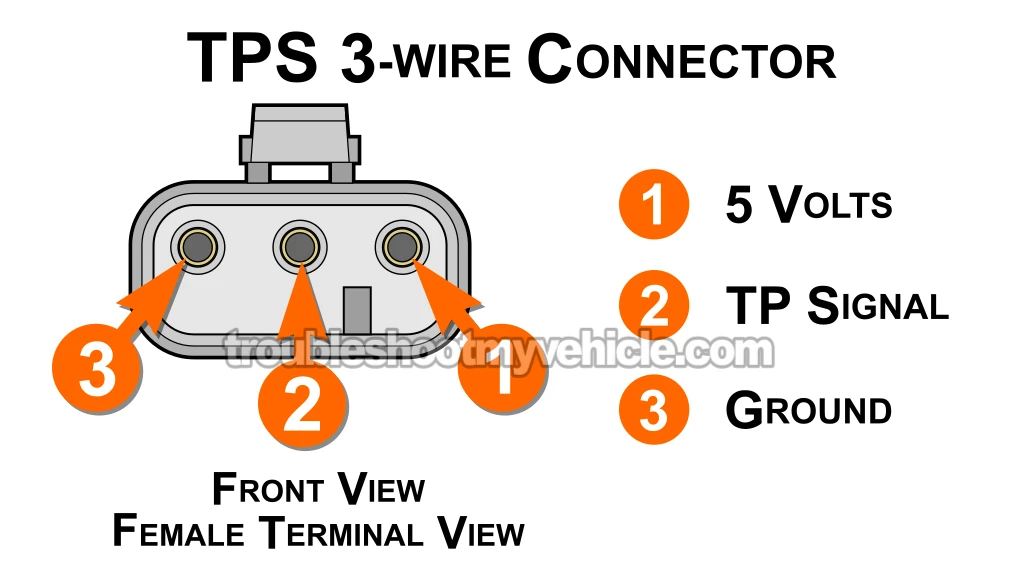TEST 2: Making Sure The TPS Is Receiving 5 Volts

If the TP sensor's voltage signal is stuck at a single value, there's a strong possibility it's simply not getting any power.
In this second test, we're going to check whether the violet with white stripe (VIO/WHT) is supplying between 4.5 and 5 Volts DC.
The VIO/WHT wire connects to terminal number 1 of the sensor's connector, as shown in the illustration above.
To confirm that the VIO/WHT wire is delivering the correct voltage, we'll use our multimeter for a quick voltage test.
Let's get started:
- 1
Unplug the TP sensor from its electrical connector.
- 2
Set your multimeter to DC Volts mode.
- 3
Attach the black lead from the multimeter to the battery's negative (-) terminal.
- 4
Turn the ignition key to the ON position, but don't start the vehicle.
- 5
Use the red multimeter lead to carefully probe terminal 1 on the TP sensor's connector.
NOTE: Double-check that terminal 1 is indeed connected to the VIO/WHT wire. - 6
Your multimeter should read between 4.5 and 5 Volts DC.
Now let's interpret your results:
CASE 1: You get a reading of 4.5 to 5 Volts. That confirms the sensor is receiving power —just what we want.
Next, we'll verify that it's also getting a good Ground connection. Go to: TEST 3: Making Sure The TPS Is Receiving Ground.
CASE 2: You're not seeing 4.5 to 5 Volts. Without that power, the TPS won't be able to output its changing voltage signal.
The most common reasons for a missing 5V supply are:
- A break or open-circuit in the wiring between the TPS connector and the fuel injection computer.
- A rare internal problem inside the computer itself.
While I don't cover how to track down that kind of wiring issue, you now know the TPS isn't the problem. Your next step is to trace what's interrupting that 5V supply from reaching the sensor.
TEST 3: Making Sure The TPS Is Receiving Ground

Based on the last two tests, here's what we've confirmed so far:
- TEST 1: Moving the throttle plate doesn't affect the TPS signal —it stays the same.
- TEST 2: The TP sensor is definitely receiving power.
In this final part of the test, we're going to verify that the black with light blue stripe (BLK/LT BLU) wire is delivering a proper Ground signal to the TPS.
According to the diagram above, terminal number 3 on the connector is the one linked to the BLK/LT BLU wire.
We'll do a voltage test with our multimeter to check if Ground is reaching that terminal.
IMPORTANT: The Ground connection to the TPS comes from the vehicle's fuel injection computer. Whatever you do, don't connect this circuit directly to the battery's 12 Volts —doing so will fry the computer! The voltage test below is a safe and effective way to check for Ground.
Alright, let's check for Ground:
- 1
Unplug the TP sensor from its harness connector.
- 2
Set your multimeter to DC Volts.
- 3
Place the red multimeter lead on the positive (+) battery terminal.
- 4
Turn the ignition to the ON position, but don't start the engine.
- 5
Use the black lead to carefully probe terminal 3 on the TPS connector.
NOTE: Be sure terminal 3 is connected to the BLK/LT BLU wire. - 6
Your multimeter should display a voltage reading between 10 and 12 Volts DC.
Let's break down what your result means:
CASE 1: You're seeing 10–12 Volts. That confirms the TPS is getting a solid Ground connection.
If you've already confirmed the following:
- The TPS signal voltage doesn't change when the throttle is moved (from TEST 1).
- The sensor is receiving 4.5 to 5 Volts of power (from TEST 2).
- And now, the Ground is also present (this test).
Then the throttle position sensor itself is the issue and needs to be replaced.
CASE 2: No voltage is showing on your multimeter. First, make sure you're checking the correct wire and terminal.
If you've double-checked and still don't see 10 to 12 Volts, then the problem isn't with the TPS —it's that it isn't getting Ground, so it can't generate a variable voltage signal.
Here are the most likely reasons Ground isn't reaching the sensor:
- A break or open in the wiring between the TPS connector and the fuel injection computer.
- A rare internal problem in the computer itself.
I don't cover how to troubleshoot those wiring or computer issues, but the key takeaway is: your TPS is fine —the lack of Ground is what's causing the problem. You'll need to resolve the wiring issue to get things working again.
More 5.2L, 5.9L V8 Dodge Ram Van Tutorials
You can find a complete list of 5.2L, 5.9L V8 Dodge Ram van tutorials in this index:
Here's a sample of the tutorials you'll find in the index:
- How To Test The MAP Sensor (1992-1997 5.2L, 5.9L V8 Dodge Ram Van).
- How To Test The Intake Air Temp (IAT) Sensor (1992-1997 5.2L, 5.9L V8 Dodge Ram Van).
- How To Test Engine Compression (1989-2003 5.2L, 5.9L V8 Dodge Ram Van).
- How To Test For A Blown Head Gasket (1989-2003 5.2L, 5.9L V8 Dodge Ram Van).

If this info saved the day, buy me a beer!

